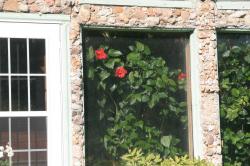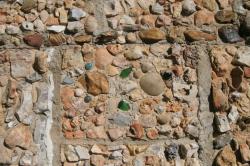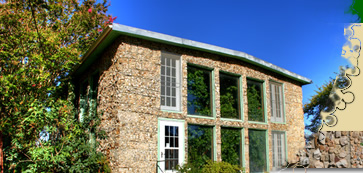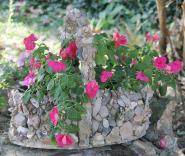 |
 |
|
|
|
|
|
|
|
| |
| The Ozark`s Strangest Dwelling |
|
| |
|
Quigley`s Castle
274 Quigley Castle Rd
Eureka Springs, AR 72632
Call Us At:
(479) 253-8311
Contact
Us by Email |
| Open March through October |
|
| |
|
 |
|
|
 |
 |
Quigley`s Castle
Ozarks Strangest Dwelling |
 |
|
Elise Fiovanti Qugley (1910-1984).

Click Image to Enlarge |
My great grandmother's maiden name was Elise Fioravanti (1910-1984). She was part Italian. She came to the Ozarks when she was nine. She loved the outdoors and began to collect rocks as she walked along a creek bed to school. When she was 18, during the depression, she married my great grandfather, Albert Quigley (1905-1972). He was the type of fellow who brought her rock collection with them to the site of his farm and lumber mill. They lived in a lumber shack and had five children. My great grandfather promised her a house with the lumber cut off their own property.
They argued about it for several months. As soon as Albert headed for work at the lumber mill one June morning in 1943, Elise Quigley gathered their children around her and ordered "we're going to tear down the house." And demolish the family's three room house they did. "when Bud came home that night, "Mrs. Quigley related, "he was living in a chicken house, where we'd moved all of our stuff." |
Mrs. Quigley had already designed her dream home. She wanted two things: Plenty of room for the robust family and a "home where I felt I was living in the world instead of in a box. I designed it in my mind, but I couldn't tell anybody what I wanted, so I sat down with scissors, paste, cardboard and match sticks and made a model."
The biggest obstacle was that the design which called for 28 huge windows. Mr. Quigley wanted to wait to build the house because glass was unavailable during the war, but now construction began immediately. Built entirely of lumber off their land and with their own labor, only $2000 in cash was spent on supplies and glass, which didn't become available for three years. The family survived the winters by tacking up material over the holes in layers.
To bring nature indoors, four feet of earth was left bare between the edges of the living space and the walls. Into the soil, which borders the rooms on the inside, Mrs. Quigley planted flowering, tropical plants that grow up to the second story ceiling. The two remaining original plants are over 70 years old now. |

Click Image to Enlarge |

Click Image to Enlarge |
Stones that Mrs. Quigley began collecting as a girl assumed an important part of the house. Working tenderly for three years, Mrs. Quigley covered the outside walls with a collection of fossils, crystals, arrowheads and stones selected from the creek beds for their beauty. A perennial garden surrounds the house.
The inside of the house is a collection of family antiques and mementoes that express Mrs. Quigley's love of nature. Especially spectacular is the "Butterfly Wall" that is beyond imagination.
This was her home and passion for another 50 years as she continued to collect and surround herself with the nature she loved. My great grandparents were very compatible; he took her everywhere she wanted to collect, as she couldn't drive. He continued to make a living with the farm and lumber mill until he passed away in 1972, at the age of 66. Elise Quigley died at the age of 74 in 1984. |
| The Quigley home, without intention, became a favorite stopping place for people traveling through the Ozarks. Now after seventy years, the Quigley's great granddaughter still welcomes guests into the family home. |
Listed on the National Register of Historic Places
Seen on HGTV |
|
|
|
|


